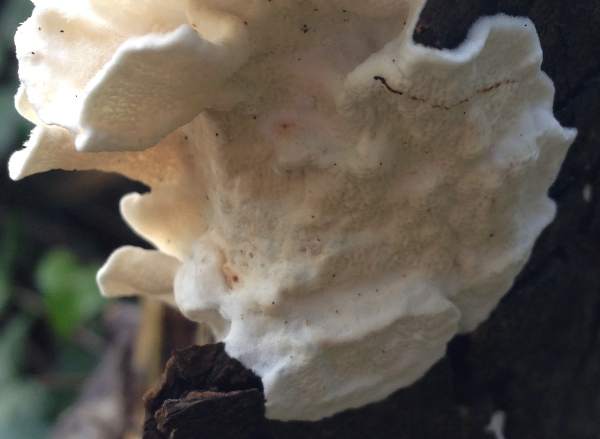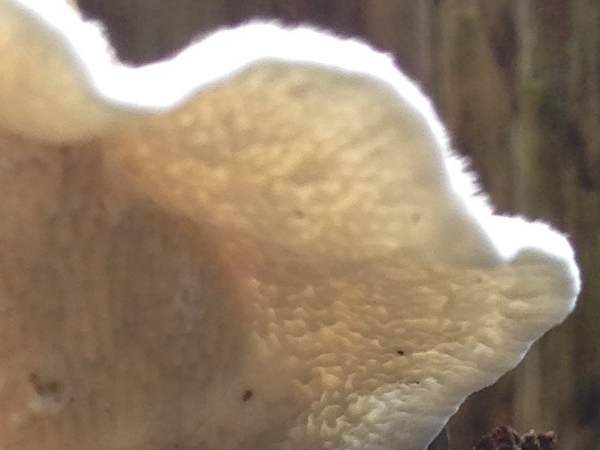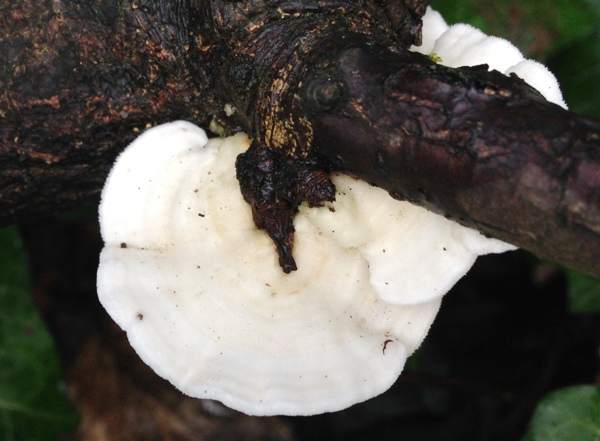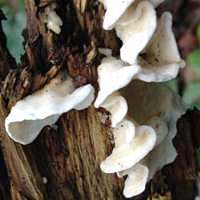Trees Birds Mammals Fish Amphibians Reptiles
Wild Algarve
Bookshop
Byssomerulius corium (Pers.) Parmasto - Netted Crust
Phylum: Basidiomycota - Class: Agaricomycetes - Order: Polyporales - Family: Phanerochaetaceae
Distribution - Taxonomic History - Etymology - Identification - Culinary Notes - Reference Sources

This corticioid (crust-like) fungus is a real beauty, especially when young and fresh and seen in its bracket form backlit by sunlight.
Distribution
Byssomerulius corium is fairly common find in Britain and Ireland. This corticioid (crust) fungus has also been recorded throughout mainland Europe as well in Asia, Africa, the Americas and Australia.

Taxonomic history
Netted Crust fungus was described in 1783 by French naturalist Jean Baptiste Francois (Pierre) Bulliard, who gave it the name Auricularia papyrina. The basionym (first valid name) dates from the 1801 publication of Christiaan Hendrik Persoon's Synopsis Methodicae Fungorum (and subsequently sanctioned in 1828 by Elias Magnus Fries) in which Netted Crust is given the name Thelephora corium (effectively - Classifying it with the various earthfan fungi).
The currently-accepted scientific name Byssomerulius corium dates from a 1967 publication by the Estonian mycologist Erast Parmasto (1928-2012), who designated Byssomerulius corium as the type species of its genus.
Synonyms of Byssomerulius corium include Auricularia papyrina Bull., Thelephora corium Pers., Boletus purpurascens DC., Merulius confluens Schwein., Merulius corium (Pers.) Fr., Merulius aurantiacus Klotzsch, and Merulius papyrinus (Bull.) Quél.

Etymology
Byssomerulius, the genus name, comes via Greek from the Latin byssus, meaning fine silk-like cloth and is probably a reference to the many fine maze-like ridges that pattern the surface of these fungi rather like interlocking jigsaw pieces, and -merulius is the name (origin obscure) of the closely-related Merulius crust fungus genus. The specific epithet corium means a skin or hide, as in leather, and is a reference to the resupinate skin-like form that the fruitbodies of this species take (at least when initially forming and in many instances throughout the life of the fruitbodies).
Identification guide
 |
Fruitbody
Irregular but mostly resupinate, sometimes forming brackets. Fruitbodies coalesce to form large patches or tiered brackets with lower (fertile) whitish surface covered in snaking net-like ridges or elongated warts. The pale upper surface, where visible, is faintly zoned and fibrous or finely downy, becoming finely hairy at the margin.
The white flesh is tough and leathery. |
| |
Spores
Elongated ellipsoidal to cylindrical, smooth, 4.5-7.5 x 2.3-3μm; hyaline or very nearly so; inamyloid.
Spore print
White. |
Odour/taste |
No noticeable odour; very tough when dry, waxy when wet, but tasteless. |
Habitat & Ecological role |
Saprobic, on fallen hardwood trees, branches and twigs, mostly on the undersides; commonly on Ash, causing white rot. |
Season |
Seen throughout the year, but shedding spores mainly in
autumn. |
Similar species |
Stereum subtomentosum is sometimes entirely resupinate and then similar in form to Netted Crust, but it is usually various shades of greyish-orange. |
Culinary Notes
These tough and tasteless fungi are inedible and of no culinary value.
Reference Sources
Ellis, J. B.; Ellis, Martin B. (1990). Fungi Without Gills (Hymenomycetes and Gasteromycetes): an Identification Handbook. London: Chapman and Hall. (Cobal Crust included as Pulcherricium caeruleum)
Paul M. Kirk, Paul F. Cannon, David W. Minter and J. A. Stalpers. (2008). Dictionary of the Fungi; CABI.
Taxonomic history and synonym information on these pages is drawn from many sources but in particular from the British Mycological Society's GB Checklist of Fungi.
Acknowledgements
This page includes pictures kindly contributed by Simon Harding.
Top of page...
Fascinated by Fungi. Back by popular demand, Pat O'Reilly's best-selling 450-page hardback book is available now. The latest second edition was republished with a sparkling new cover design in September 2022 by Coch-y-Bonddu Books. Full details and copies are available from the publisher's online bookshop...